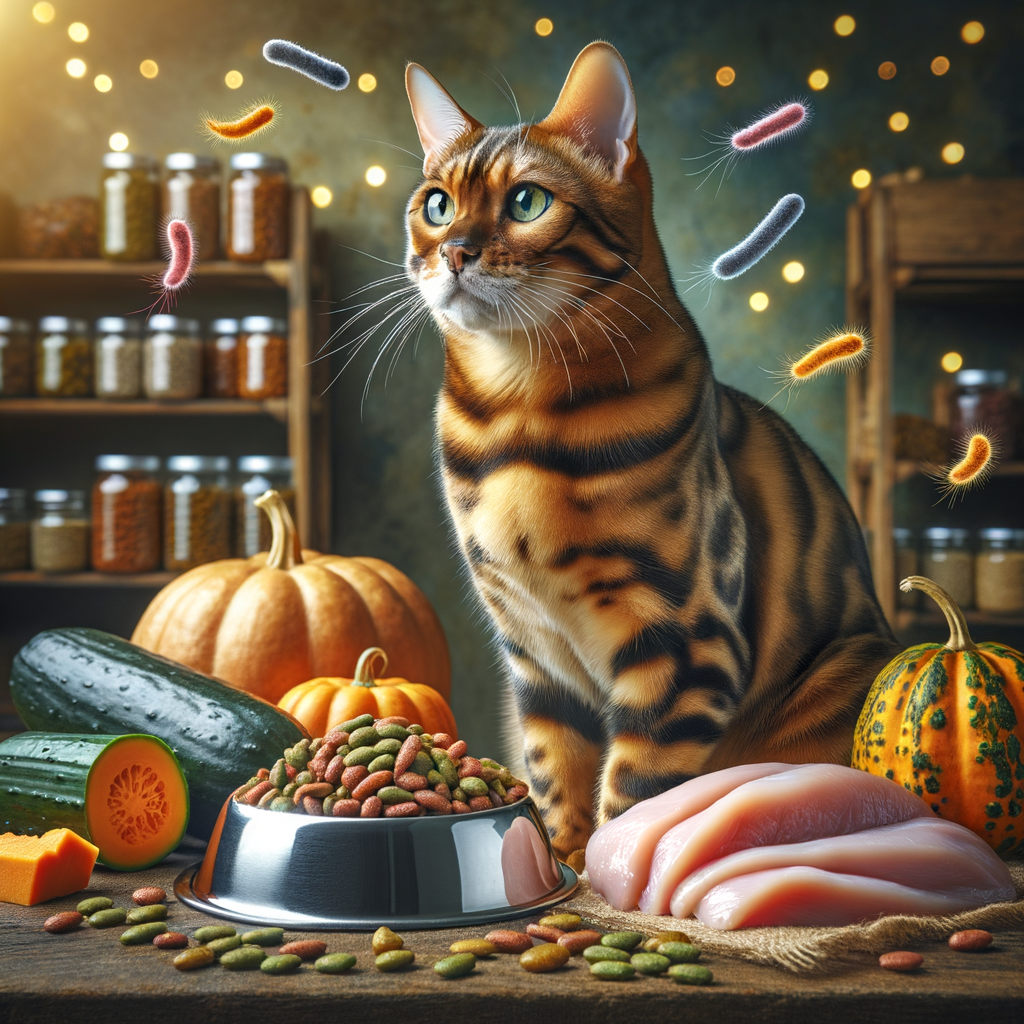
Introduction to Bengal Cat Digestion
- Overview of Bengal cat digestive system:
Bengal cats have a unique digestive system that helps them process their food efficiently. Their digestive tract is designed to break down meat, as they are obligate carnivores. This means they need a diet high in protein and low in carbohydrates. The digestive process starts in the mouth, where food is chewed and mixed with saliva. It then moves to the stomach, where acids break down the food further. Finally, nutrients are absorbed in the intestines. - Common Bengal cat digestive issues:
Bengal cats can face several digestive problems. Some common issues include hairballs, diarrhea, and constipation. Hairballs form when cats groom themselves and swallow loose fur. Diarrhea can be caused by a sudden change in diet or food allergies. Constipation might occur if the cat is not drinking enough water.
Bengal Cat Diet Tips
Choosing the Right Food
- Importance of high-quality protein: Bengal cats are active and muscular. They need food rich in high-quality protein to maintain their energy and muscle mass. Look for cat food that lists meat, like chicken or fish, as the first ingredient. High-quality protein helps in building strong muscles and supports overall health.
- Bengal cat food allergies: Some Bengal cats may have food allergies. Common allergens include grains, dairy, and certain proteins. If your Bengal cat shows signs like itching, vomiting, or diarrhea, it might have a food allergy. Consult your vet to identify the allergen and choose hypoallergenic cat food to keep your Bengal healthy.
Feeding Schedule
- Recommended feeding times:It’s best to feed your Bengal cat twice a day. Morning and evening are ideal times. This helps keep their energy levels stable throughout the day.
Some Bengal cats may prefer three smaller meals. If you notice your cat is more active or hungry, consider adding a midday snack.
- Portion sizes for a healthy Bengal cat:Portion sizes depend on your cat’s weight and activity level. On average, a Bengal cat needs about 25-30 calories per pound of body weight each day.
For example, a 10-pound Bengal cat should eat around 250-300 calories daily. This can be divided into two or three meals.
Always check the food packaging for specific serving recommendations. Adjust portions if your cat is gaining or losing weight.
Bengal Cat Gastrointestinal Health
Common Gastrointestinal Problems
- Identifying Bengal cat digestion problems: Bengal cats can have sensitive stomachs. Look for signs like vomiting, diarrhea, or loss of appetite. If your cat shows these symptoms, it might have a gastrointestinal issue. Early detection is key to managing these problems effectively.
- Treatment options for common issues: There are several ways to treat gastrointestinal problems in Bengal cats. Your vet may recommend a special diet or prescribe medication. Probiotics can also help improve digestion. Always consult your vet before starting any treatment.
Preventing Gastrointestinal Issues
- Importance of Regular Vet Check-UpsVets can spot early signs of gastrointestinal issues before they become serious. According to Wikipedia, routine vet visits help in early detection of health problems. This can save your cat from pain and costly treatments later.
During a check-up, the vet will examine your cat’s stomach and intestines. They may also run tests to ensure everything is working well. Regular visits help keep your Bengal cat happy and healthy.
- Role of Diet in Bengal Cat Gastrointestinal HealthDiet plays a big role in keeping your Bengal cat’s stomach healthy. A balanced diet with the right nutrients helps prevent digestive issues. Feeding your cat high-quality food can make a big difference.
Nutrient Benefit Protein Builds strong muscles Fiber Aids in digestion Water Keeps the digestive system hydrated
Dealing with a Bengal Cat Sensitive Stomach
Identifying a Sensitive Stomach
- Signs your Bengal cat may have a sensitive stomach:Look for symptoms like vomiting, diarrhea, and a lack of appetite. Your cat might also show signs of discomfort after eating, such as excessive licking of their lips or pacing around. If your cat frequently has loose stools or seems to be in pain, these could be indicators of a sensitive stomach.
- When to consult a vet:If you notice any of the signs mentioned above, it is best to consult a vet. A vet can help determine if your Bengal cat has a sensitive stomach or if there is another underlying issue. Early consultation can prevent more serious health problems. Regular check-ups and discussing any changes in your cat’s behavior or eating habits with your vet can ensure your Bengal cat stays healthy.
Feeding a Bengal Cat with a Sensitive Stomach
-
Choosing the right food for a sensitive stomach
Look for high-quality, easily digestible ingredients. Foods with limited ingredients can help reduce the risk of stomach upset. Avoid fillers like corn, wheat, and soy. These can be hard for your cat to digest.
Some cats do well on a grain-free diet. Others may need a special formula designed for sensitive stomachs. Always check the label for essential nutrients. Your cat needs a balanced diet to stay healthy.
Food Type Benefits Grain-Free Reduces risk of allergies and stomach issues Limited Ingredient Minimizes potential allergens Special Formula Designed for sensitive stomachs -
Introducing new foods gradually
When switching your Bengal cat to a new food, do it slowly. A sudden change can upset their stomach. Start by mixing a small amount of the new food with their current food. Gradually increase the new food while decreasing the old food over 7-10 days.
Here is a simple plan to follow:
- Days 1-3: 25% new food, 75% old food
- Days 4-6: 50% new food, 50% old food
- Days 7-9: 75% new food, 25% old food
- Day 10: 100% new food
Watch your cat closely during this transition. If they show signs of stomach upset, slow down the process. Always provide fresh water and monitor their health.
Bengal Cat Nutrition for Optimal Digestion
Key Nutrients for Bengal Cats
- The role of proteins, fats, and carbohydrates:Bengal cats are active and need high-quality protein sources like chicken or fish. Fats provide energy and help absorb vitamins. Healthy fats can be found in fish oil and chicken fat. Carbohydrates, though not as crucial, offer quick energy. However, too many carbs can lead to weight gain.
- Importance of vitamins and minerals:Vitamins and minerals support various bodily functions. For example, Vitamin A is vital for vision and immune health, while calcium strengthens bones. Ensure your Bengal cat’s diet includes a balanced mix of these nutrients.
| Key Nutrient | Importance | Sources |
|---|---|---|
| Proteins | Muscle growth and repair | Chicken, Fish |
| Fats | Energy and vitamin absorption | Fish oil, Chicken fat |
| Carbohydrates | Quick energy | Rice, Sweet potatoes |
| Vitamins | Vision, Immune health | Carrots, Liver |
| Minerals | Bone strength | Calcium supplements, Fish |
Bengal Cat Feeding Guide
-
How much to feed your Bengal cat
The amount of food depends on their age, weight, and activity level. On average, an adult Bengal cat needs about 25-30 calories per pound of body weight each day. For example, if your Bengal cat weighs 10 pounds, they will need around 250-300 calories daily.
Weight (lbs) Calories per Day 5 125-150 10 250-300 15 375-450 -
How often to feed your Bengal cat
Most Bengal cats do well with two meals a day – one in the morning and one in the evening. Kittens, however, need more frequent meals, about 3-4 times a day, because they are growing and need more energy.
Here is a quick guide:
- Kittens: 3-4 meals per day
- Adults: 2 meals per day
Role of Digestive Enzymes in Bengal Cat Digestion
- Bengal cat digestive enzymes
Digestive enzymes are special proteins that help break down food into smaller pieces. This makes it easier for the body to absorb nutrients. Bengal cats, like all cats, need these enzymes to digest their food properly. There are different types of digestive enzymes, each with a specific job. For example, amylase breaks down carbohydrates, protease breaks down proteins, and lipase breaks down fats.
- How digestive enzymes support Bengal cat healthy digestion
They help ensure that your cat gets all the nutrients it needs from its food. Without enough digestive enzymes, your Bengal cat might have trouble digesting food. This can lead to problems like bloating, gas, or even malnutrition.
Adding digestive enzyme supplements to your Bengal cat’s diet can help. These supplements can support your cat’s digestion, especially if it has a sensitive stomach. Always talk to your vet before adding any supplements to your cat’s diet.
Ensuring a Healthy Digestion for Your Bengal Cat
- Recap of Bengal cat diet tips:
- Feed your Bengal cat a balanced diet with high-quality protein.
- Include fiber-rich foods to aid digestion.
- Provide fresh water daily to keep your cat hydrated.
- Avoid giving your cat human food, especially those that are toxic to cats.
- Monitor your cat’s weight and adjust portions as needed.
- Final thoughts on Bengal cat digestive health:By following the diet tips provided, you can help prevent common digestive issues. Observe your Bengal’s specific needs and consult with a vet for personalized advice.






